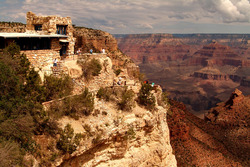 Some of the best things in life truly are free, particularly in our national parks. And even those things that aren’t free are still an incredible value, in part because every item with a price tag in every U.S. national park has the approval of the National Park Service.
Some of the best things in life truly are free, particularly in our national parks. And even those things that aren’t free are still an incredible value, in part because every item with a price tag in every U.S. national park has the approval of the National Park Service.
Here’s a few budget-friendly ideas from National Park concessioner Xanterra Parks & Resorts:
Free experiences:
Spot an owl. Or a bear, elk, wolf, otter, bighorn sheep, pronghorn, coyote, bison or trumpeter swan. The Lamar Valley in the northern part of Yellowstone National Park is often called the “American Serengeti” because of its abundant wildlife. Some good binoculars and a little patience are all you need to observe the wonders of the park’s wildlife. Xanterra also offers a variety of guided wildlife-watching experiences.
Go low. At 282 feet below sea level, Badwater Basin in California’s Death Valley National Park is one of the lowest places in the world. The vast salt flats are typically bone-dry but can turn into a ready-made lake after a big rainstorm. Look up at mountainside sign marking sea level posted well above the Badwater Basin viewpoint. No, up a little higher. Feeling small yet?
Walk in the footsteps of presidents. Six presidents – and Three Stooges – have stayed at Yellowstone’s Old Faithful Inn. It was built for $140,000 in 1904 and is one of the most famous buildings in any national park. A Xanterra historian tells travelers about the inn’s colorful history during free walking tours offered several times a day throughout the summer.
Get high. Some hikers have called it one of the best short hikes in a national park. Though only five miles round trip, the hike to Angel’s Landing in Zion National Park is a strenuous but breathtakingly beautiful hike. The view from the top of Angel’s Landing is worth the 21 steep switchbacks – called “Walter’s Wiggles” – and the final white-knuckle half mile. This is a hike for experienced trekkers who have no fear of heights. Take a deep breath at the top. And then look at the view. You won’t forget it.
Count the California condors. One of the rarest birds in the world, the California condor population dwindled to only 22 birds in the early ‘80s. Thanks to a captive breeding program, six birds were eventually reintroduced to the wild, and the Grand Canyon was chosen because of the park’s many cliffs on which the birds can roost. Today, there are approximately 60 birds in the State of Arizona, and many of them live in the Grand Canyon. With a wingspan of 9½ feet, it is easy to spot when it soars over the Canyon.
Hike to a doo in the dark. Bryce Canyon National Park’s mysterious-looking hoodoos – red-rock spires – are even more interesting when explored by the light of the moon. The National Park Service offers moonlit hoodoo hikes three times each month during the full moon.
Wish on a star. Stargazing is a simple, free, safe and rejuvenating activity for the whole family. Because there is already minimal exterior lighting surrounding the lodges in most national parks, guests need only walk a few steps away to observe the night sky in relative quiet. Death Valley National Park in particular is known for its dark skies initiatives. The National Park Service also offers a variety of free stargazing programs in Yellowstone.
Nearly free experiences:
Become a Junior Ranger. The National Park Service’s perennially popular Junior Ranger program – available at many national park locations – continues to challenge and entertain young visitors. Parents like these programs too. While children are earning their Junior Ranger Patches, they are also learning about the importance of national parks. But don’t spoil the fun by telling them they’re learning. The Junior Ranger program is free in some parks, and others charge a nominal fee. For complete information, visit www.nps.gov.
Arrive. A carload of visitors can purchase a seven-day entrance permit for just $25 in Yellowstone, the Grand Canyon and other parks. The fees collected by the National Park Service go back into the park for improvements such as the construction of a new visitor center, maintenance projects and a variety of other programs. Travelers who plan to visit more than one park should consider purchasing an annual park pass or an “America the Beautiful” interagency pass.
Reel in a big one. Fly fishing is excellent on many of Yellowstone National Park’s rivers, streams and lakes. Anglers over the age of 15 must purchase a fishing license at a ranger station, visitor center or gift shop. A three-day license is $15.
Freeze your brain. There’s something about having an ice cream cone in a national park. Mount Rushmore’s “monumental scoop” of ice cream is the quintessential ice cream experience, especially when enjoyed in the shadow of the four sixty-foot high faces of Presidents George Washington, Theodore Roosevelt, Abraham Lincoln and Thomas Jefferson. On a hot summer day, travelers line up for these crowd-pleasing treats. Also popular with cone connoisseurs: the Old Faithful Inn in Yellowstone, Bright Angel Fountain in the Grand Canyon, the Red Rock Grill in Zion and the Harvey’s Diner in Petrified Forest and Café at Trail Ridge in Rocky Mountain National Park.
Discover gold. For $11, you can tour a remote Moorish-style castle built by a Chicago millionaire and named for his friend, an amiable swindler called “Death Valley Scotty.” Located 50 miles from the Furnace Creek Inn & Ranch Resort, Scotty’s Castle is a favorite day-trip among park visitors. National Park Service tour guides in period costumes from the ‘30s tell stories of Scotty’s adventures, including the so-called gold mine buried directly under the castle.
Not free, but the experience will be priceless:
Take a taxi. Grand Canyon National Park’s long-eared taxis – mules – have been making the trek into the canyon for more than 100 years. Leaving every morning from the park’s historic corral and heading down the Bright Angel Train, these sure-footed creatures have become famous in their own right. Age, weight and other restrictions apply. The seven-hour mule ride to Plateau Point is $162.06 per person and includes a box lunch and taxes. The spectacular view from the trail is, of course, free.
Claim your steak. Really, there’s nothing quite like a great steak. Some of the best places to enjoy a good steak in a national park include the Arizona Steakhouse in the Grand Canyon, Wranglers Steakhouse in Death Valley and Old West Dinner Cookout at the Roosevelt Lodge.
Drop out. Experience backcountry camping with car-camping convenience on the shores of Yellowstone Lake. Called the Otter, the drop-off boat can carry up to six passengers and gear and up to four canoes or kayaks (depending on total weight and weather conditions) to shoreline destinations otherwise considered too far to paddle. The Otter will return to pick up the group at a predetermined time and place. Per-hour rate is $76 plus tax with a two-hour minimum per each leg of the drop. To book backcountry drop-offs, call (1) 307-242-3893.
Arrive by train. The Grand Canyon Railway based in Williams, Ariz., 50 miles south of Grand Canyon National Park, offers a variety of train experiences for travelers looking for a car-free experience. A worthwhile splurge is to upgrade to the Luxury Parlor Car, which includes an observation platform. The train excursions begin with a kid-pleasing Wild West Shootout.
Travel in coach. Another guaranteed kid-pleaser, Xanterra’s stagecoaches are replicas of those used by the park’s early visitors. Drawn by two horses, each stagecoach travels through sagebrush flats near the Roosevelt Lodge. Rides are an hour long and offered several times a day. Adults, $10; children 2-11, $ 8; under two, free. The Grand Canyon offers a variety of motorcoach tours. The popular 90-minute Sunset Tour, for example, takes visitors to one of the Canyon’s of the most panoramic South Rim viewpoints, Yaki or Mojave Point. Knowledgeable and entertaining drivers introduce participants to the historic Grand Canyon village area and discuss the contemporary human history of the park. Adults, $18; children under 16 ride free when accompanied by an adult.
Eat, drink and be healthy. Xanterra Parks & Resorts’ dining rooms – from the elegant El Tovar Dining Room in Grand Canyon National Park to the award-winning Annie Creek Restaurant in Crater Lake National Park – are committed to offering a variety of culinary choices, including sustainable cuisine. Examples of healthy or sustainable ingredients include farm-raised game, wild Alaska salmon, organic goat cheese, soy milk, and fair-trade certified coffee.
For more information about Xanterra Parks & Resorts and online reservations visit www.xanterra.com. For lodge reservations and more information about Grand Canyon, Bryce Canyon, Zion, Crater Lake or Death Valley, you may also call (1) 303-297-2757 or toll-free at (1) 888-297-2757. For Yellowstone reservations, call (1) 307-344-7311 or toll-free at (1) 866-439-7375.
###
Xanterra Parks & Resorts® (consisting of Xanterra Parks & Resorts, Inc. and Xanterra South Rim, L.L.C.) operates lodges, restaurants and other concessions at national parks and state parks and resorts. Xanterra Parks & Resorts is the country’s largest park concessioner. Xanterra operates concessions in the following locations: Yellowstone, Bryce Canyon, Zion, Crater Lake, Death Valley, Rocky Mountain and Petrified Forest National Parks, and Mount Rushmore National Memorial; and at the Silverado Resort in Napa, Calif.; and eight Ohio State Parks. Its affiliate Xanterra South Rim, L.L.C. operates concessions at the South Rim of the Grand Canyon. Xanterra also operates the Grand Canyon Railway in Williams, Ariz.
For more information about Xanterra, links to individual properties and reservations numbers, visit www.xanterra.com.
